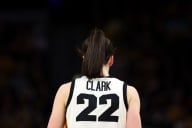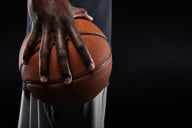You have /5 articles left.
Sign up for a free account or log in.
Tens of thousands of current and former college athletes could now be eligible for a cut of the revenue generated through video games and other merchandise that portrays their likeness, after Electronic Arts Inc. and the Collegiate Licensing Company settled in the massive antitrust suit O’Bannon vs. National Collegiate Athletic Association.
EA and CLC, which licenses the trademarks of most college logos used in the games, were also targeted in the O'Bannon case, and the settlement, first reported by The Birmingham News, stipulates that it “does not affect Plaintiffs’ claims against the National Collegiate Athletic Association.” The settlement also applies to the lawsuit brought by the former Arizona State University quarterback Sam Keller, whose case merged with O’Bannon’s in 2009, and EA has also reportedly settled a separate lawsuit brought by the former Rutgers University quarterback Ryan Hart.
The news surfaced barely an hour after EA announced it would not produce its popular “NCAA Football” video game next year, and possibly never again, due to continuing litigation. And despite the NCAA’s announcement in July that it would end its contract with EA and no longer lend its name to the game, the association remained steadfast in its position Thursday that it would not settle in O’Bannon. That case, which began with only former athletes as plaintiffs but was recently allowed to add current ones, was filed by the former University of California at Los Angeles basketball star Ed O’Bannon.
“We’re prepared to take this all the way to the Supreme Court if we have to,” NCAA General Counsel Donald M. Remy told USA Today on Thursday, before news of the settlement broke. “We are not prepared to compromise on this case.”
But EA and CLC’s waving of the white flag will inevitably raise even more questions about the NCAA’s legal standing. While the NCAA has maintained that athletes have no right to any profits earned by companies that portray or broadcast their image (and has reportedly been beefing up its defense team), the settlement does not appear to support that stance.
“EA Sports and CLC, while probably not admitting legal liability, clearly were concerned enough that the courts could find that they violated the rights of publicity of college athletes and reached a settlement, and that doesn’t bode well for the NCAA,” said Warren K. Zola, assistant dean for graduate programs at Boston College and an expert on sports business law. “I have yet to see a solid legal argument by anybody who is not biased or benefiting from the existing system who doesn’t feel that there’s some violation on the right of college athletes.”
The specific terms of the settlement are confidential pending court approval, but it is estimated to affect between 100,000 and 200,000 current and former football and basketball players who have been featured in the video games since 2003. The damages awarded to individual athletes are expected to vary.
“We learned of this notional settlement today,” Remy said via an e-mail statement Thursday night. “We have asked for, but have not yet received, the terms so we cannot comment further.”
NCAA rules prohibit students from profiting at all off their image or status as athletes, and it was unclear Thursday night whether those who are affected by the settlement and still in college (for example, Johnny Manziel, the Texas A&M quarterback who last year became the first freshman to win the Heisman trophy) would jeopardize their athletic eligibility by accepting a check.
The NCAA and its member universities have a lot more riding on O’Bannon than EA or CLC did: the association is charged with violating antitrust law by capping workers’ compensation, and in addition to signage and other merchandise, the plaintiffs seek damages for their images used in television broadcasts. So instead of applying only to athletes depicted in two video games, a ruling could apply to every player to have been on TV – and to every conference and university that benefits financially from television contracts (so, all of them) with a whole lot more money at stake.
"It looks like it’s shaping up to exactly what everybody expected: a showdown at the end between the plaintiffs and the NCAA over whether student-athletes can be paid,” said Christian S. Dennie, a lawyer at the Texas firm Barlow Garsek & Simon. “They’re the lone ranger, they’re the last defendant left…. There’s a lot riding on this lawsuit for, really, the future of the NCAA.”
The O’Bannon case is still awaiting class action certification. Some (including the NCAA and university presidents) have speculated that if the case proceeds with class action status and the athletes emerge victorious, it could be a major financial blow and change the way college sports are run.
If the NCAA loses the case, the ripple effect will depend on the extent to which the association is found to have violated antitrust law, Zola said. But it could result in billions of dollars in damages.
“What I continue to be stunned by, quite frankly, is the fact that the NCAA refuses to settle and come to the table and find some common ground that makes sense both for college athletes and for the existing system of college athletics as we know it,” he said. “It’s really important for me and to many that college athletics at every level still maintain a role in higher education. And at this point, the only way it appears to me that that’s possible would be through negotiations and settlements.”








